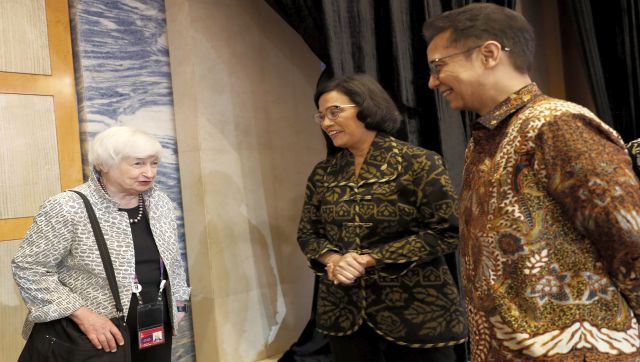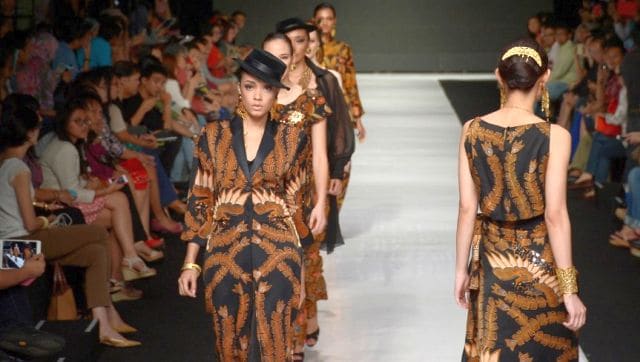The G20 summit of world leaders has begun in Indonesia’s Bali and as much attention is being paid to the issues being discussed and geopolitics being played out, attention is also being paid to what the dignitaries and leaders are wearing at the annual meet of world powers.
Catch all the live updates from the G20 summit HERE
Many dignitaries and G20 sherpas have been seen wearing the traditional batik shirts at the meet. Even new owner of Twitter Elon Musk, who attended a session at the meeting virtually, was seen in a green Bomba Batik shirt. Delegates at the meeting have also been welcomed to the nation with fashionable batik scarves.
Moment when @elonmusk doing virtual for KTT G20.
Elon musk looks handsome wearing batik from Indonesia 💙☺️ pic.twitter.com/sZkDHaX105
— Bianca $COOKIES 🍪🔥 (@urpa9ex) November 14, 2022
Here’s a better look at what exactly batik is and how it’s become the country's most recognisable art forms.
What is batik?
Batik is a technique of wax-resist dyeing applied to a whole cloth, or cloth made using this technique.
The word batik is Javanese in origin. It comes from the Javanese word amba (‘to write’) and titik (‘dot’), or may derive from the word beCík (‘to tattoo’). The word was first recorded in English in the Encyclopaedia Britannica of 1880, in which it is spelled battik. It is attested in the Indonesian Archipelago during the Dutch colonial period in various forms: mbatek, mbatik, batek and batik.
In batik, the artist draws dots and lines with a spouted tool called a canting, or by printing the resist with a copper stamp called a cap. The applied wax resists dyes and therefore allows the artisan to colour selectively by soaking the cloth in one colour, removing the wax with boiling water, and repeating if multiple colours are desired.
Today, batik is found in various countries, including Indonesia, Singapore, Malaysia, India, Bangladesh, Sri Lanka, and Nigeria. However, the batik of Indonesia is best-known and in October 2009, UNESCO designated Indonesian batik as a Masterpiece of Oral and Intangible Heritage of Humanity.

History of Batik
Experts disagree to the precise origins of batik but there is mention of ‘fabrics highly decorated’ in Dutch transcripts from the 17th century. Some experts feel that batik was originally reserved as an art form for Javanese royalty.
Other scholars disagree that batik was only reserved as an art form for royalty, as they also feel its use was prevalent with the rakyat, the people. It was regarded an important part of a young ladies accomplishment that she be capable of handling a canting (the pen-like instrument used to apply wax to the cloth) with a reasonable amount of skill, certainly as important as cookery and other housewifery arts to Central Javanese women.
Different Batik patterns
There are different batik patterns and each of them have their own corresponding meaning. In fact, some patterns are meant for specific purposes and have special meaning attached to it.
For instance, the geometric batik pattern parang. This design, which has long, narrow symbols similar to a sword or the letter ‘S’ is regarded as a symbol of protection and security. The legend has it that a Javanese Prince named Panji was protected because he was wearing parang batik.
‘Sekar jagad’, another batik print, of floral designs is the most often choice for brides, as it conveys love and happiness.
Another popular batik print is ‘Ulamsari Mas’. It illustrates vivid motifs with images of shrimp and fish. Fishing is one of the livelihoods of the Balinese people as the island is surrounded by rich marine life. Bali created this batik to show their appreciation of the island’s natural resources of fish, seafood, and raw materials. Hence, Ulamsari mas patterns depict the livelihood and prosperity of the Balinese people.
The batik cloth is also used for death ceremonies, namely as a cover for the body. The batik motif that symbolises grief is the slobok motif. This batik motif symbolises the hope that spirits will find it easy and smooth on their way to God.

Batik in India
Batik is also found in India and some experts believe that the trade routes in the olden days helped in the spread of batik from Indonesia to India.
The history of Indian batik can be traced as far back as 2,000 years. It is said that traditionally, the Khatri community of Gujarat were the only set of artisans for this art.
Over a period of time, Batik got relegated to the background in India. However in the 20th century, Batik was introduced as part of the syllabus in the University of Shanti Niketan, Kolkata. Thereon, the resurgence of Batik began.
Today, the finest Batik designs in India come from the artisans of Cholamandalam near Chennai, Tamil Nadu. Batik printing is also done in Gujarat, Rajasthan, Andhra Pradesh, Maharashtra, West Bengal and Madhya Pradesh.
With inputs from agencies
Read all the Latest News, Trending News, Cricket News, Bollywood News,
India News and Entertainment News here. Follow us on Facebook, Twitter and Instagram.

0 Comments: